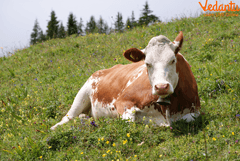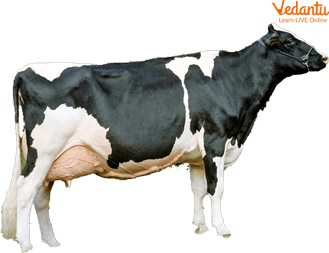




Introduction to Cattles and Its Importance
Cows or cattle are seen as the world's best-domesticated animals and are usually worshipped in countries like India, and considered sacred. The adult female is known as a cow and the adult male is known as a bull. Known for their friendliness and motherhood, cows are well related to human mothers.
The English language has several names to call cows at different stages of their life. As a calf at the early stage, a cow and its importance is very high. It is reared for varied reasons including milk, cheese, dairy products, also for meat such as beef and veal, and materials such as leather from their skin. In older times, bulls, specifically, were used to pull the cart and plough the field.

Cattle
Types of Cattles
Dairy Cattle
Dairy cattle are used for milking. Most farms will have a herd of cows, which they make sure is regularly matting with a bull to produce calves to keep the milk supply going.
Cattles are kept in sheds and barns most of their lives and are provided with feed specially adapted for cows. They have enough room so that they can lie down comfortably which allows them to move properly. Organic high-quality milk is usually produced by cows that pasture on good land with a good supply of grass. Cows are usually milked at least twice a day; hence, farmers need to have easy access to the cows so that they don’t have to travel long distances for milking.
Beef Cattle
Beef cattle are used to provide meat. The cows within a herd are used to give birth and in rearing the calves. Depending on the specific breed, they are used as per the need and importance. Steers cattle are used for beef because they are placid and will not fight against each other, and live happily. The meat varies - the meat of the young calf is called veal and the older cattle meat is called beef.
Highland Cattle
Highland cattle live in the Scottish Highlands. Their body type allows them to adapt to the changing weather. Their coats are very unique and long. It’s double-layered and thick on the outside, with oily outer hair which runs over the body and provides layering. This unusually long layering of hair keeps the Highland cow warm during the cold winter months as the weather in Scotland can be very unpredictable and usually cold.
Jersey Cattle
Jersey is in the area of the British Channel Islands between England and France. It’s believed that Jersey Cow is mostly found in this area. They are typically light brown in colour, but this can vary, as some are also black with patches. However, a true Jersey cow will have a black nose bordered and a white muzzle.

Jersey Cow
Fun Facts For Kids:
A cow eats almost 40 pounds in a day.
Cows have a tendency to listen to higher and low volume sounds than humans.
Cows are often seen chewing; they chew at least fifty times in a minute.
When you see a cow sitting and standing, they do that almost fifteen times a day.
The cow never bites the grass, instead rolls its tongue over the grass to uproot it.
Cows can see 300 degrees from their eye and merely can’t see what is directly behind them.
The time a cow takes to develop and deliver a baby is the same as a human.
A typical day for a cow is 8 hours eating, chewing their cud for 8 hours, and 8 hours sleeping.
They make saliva of a total of 125 pounds daily.
They have one stomach divided into four divisions for digestion.
Cows can pick and lick their noses with their tongues.
The age of a cow can be estimated by counting the rings made on its horns.
Summary
A group of cows is called cattle, and they are usually reared for milk and meat. Cows are known by different names as per sex, age, region, and use. Like other animals, cows have amazing fun facts related to their body as per vision, hearing, age, and other organs. Cows are used for varied purposes; to summarise, basically for milking, flesh, and as domestic animals.
FAQs on Fun Facts about Cattles for Kids
1. How long can cows live?
The productive lifespan of average cows is between 2.5 and 4 years in most developed dairy industries. Cows calve for the first time at 2 years of age, which brings their total lifespan from birth to death between 4.5 to 6 years. The natural life expectancy of dairy cattle is approximately 20 years, however.
2. How many stomachs does a cow have?
The cow has four stomachs and undergoes a special digestive process to break down the tough and coarse food it eats. When the cow first eats, it chews the food just enough to swallow it. The unchewed food travels to the first two stomachs, the rumen, and the reticulum, where it is stored until later.
3. How many times can a cow give birth?
A cow could give birth more than once during a year if she rebreeds quickly. Good management practices when raising cattle recommend waiting to rebreed cattle until their calves are older. If a cow rebreeds within 82 days of calving, she will give birth in one year.









